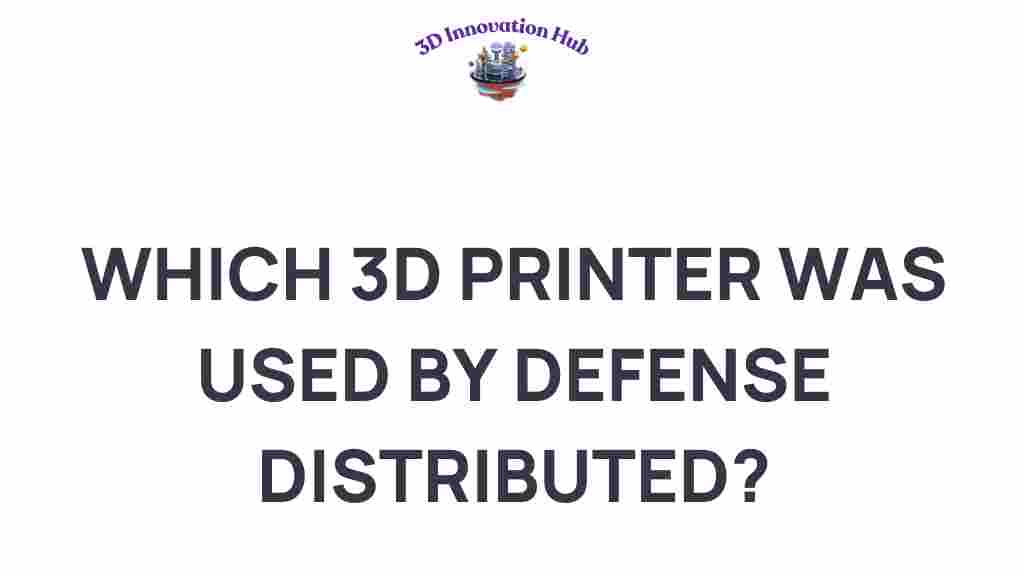Unveiling the 3D Printer Behind Defense Distributed’s Innovations
In recent years, the world of 3D printing has undergone a radical transformation, particularly in the domain of firearms and DIY manufacturing. One of the key players in this innovative landscape is Defense Distributed, a company that has made headlines for its groundbreaking work in open-source gun manufacturing. This article will explore the technology behind Defense Distributed’s innovations, the implications of their work, and how 3D printing is reshaping the future of manufacturing.
Understanding 3D Printing Technology
At its core, 3D printing, also known as additive manufacturing, is a process that creates three-dimensional objects by layering materials based on digital models. This technology has evolved significantly, enabling the production of complex designs that were previously impossible to achieve with traditional manufacturing methods.
- Materials Used: 3D printers can utilize a variety of materials, including plastics, metals, and even biological materials.
- Process: The typical 3D printing process involves three main steps: creating a 3D model, slicing the model for the printer, and printing the object layer by layer.
- Types of 3D Printing: There are several methods of 3D printing, including Fused Deposition Modeling (FDM), Stereolithography (SLA), and Selective Laser Sintering (SLS).
The rise of 3D printing technology has opened up new avenues for innovation, particularly in the context of personal manufacturing. This has led to a growing interest in the DIY community, where individuals can create custom products tailored to their specific needs.
Defense Distributed: Pioneering Open-Source Firearms
Defense Distributed is a company founded by Cody Wilson, which gained notoriety for its development of the “Liberator,” the first fully 3D-printed firearm. This innovation sparked a global conversation about the legal and ethical implications of 3D-printed firearms.
Here are some key aspects of Defense Distributed’s contributions:
- Open-Source Philosophy: The company promotes an open-source model, allowing users to access, modify, and improve upon firearm designs freely.
- Legal Challenges: Defense Distributed has faced numerous legal battles regarding the distribution of digital firearm blueprints.
- Community Engagement: By fostering a community of makers and enthusiasts, Defense Distributed has cultivated a culture of innovation in the realm of DIY firearms.
The 3D Printing Process at Defense Distributed
The process of creating a firearm using 3D printing involves several steps, which typically include:
Step 1: Design Creation
The first step is to create a digital model of the firearm. This can be done using CAD (Computer-Aided Design) software, which allows designers to create precise specifications for each component.
Step 2: Slicing the Model
Once the design is complete, it must be sliced into layers using slicing software. This software converts the 3D model into G-code, which is a language that 3D printers understand.
Step 3: 3D Printing
Next, the sliced model is sent to the 3D printer, which begins the printing process. The printer lays down material layer by layer until the object is fully formed. Various printers can be used, including:
- FDM Printers: Commonly used for plastic parts.
- SLA Printers: Ideal for high-detail components.
- SLS Printers: Suitable for metal parts and complex geometries.
Step 4: Post-Processing
After printing, the firearm components often require post-processing, which can include cleaning, assembly, and finishing touches. This step is crucial for ensuring the functionality and safety of the final product.
Legal Implications of 3D Printed Firearms
The rise of 3D printing in the firearms sector has raised significant legal questions. Here are some key considerations:
- Regulatory Framework: In many countries, firearms are heavily regulated, and the legality of 3D-printed guns varies significantly.
- Distribution of Blueprints: The sharing of digital blueprints for firearms has been a contentious issue, leading to legal challenges and debates about free speech and safety.
- Safety Concerns: There are concerns regarding the safety and reliability of 3D-printed firearms, as well as the potential for unregulated manufacturing.
As technology advances, the legal landscape surrounding 3D printing will continue to evolve, necessitating ongoing dialogue among policymakers, manufacturers, and the public.
Troubleshooting Common Issues in 3D Printing Firearms
<pWhen engaging in DIY 3D printing, particularly with firearms, users may encounter various issues. Here are some common problems and tips for resolving them:
Problem 1: Print Failures
Print failures can occur due to a variety of reasons, including:
- Incorrect Temperature Settings: Ensure that the printer is set to the appropriate temperatures for the material being used.
- Bed Adhesion Issues: Use adhesives or specific bed surfaces to improve adhesion during printing.
Problem 2: Inaccurate Dimensions
Inaccurate prints can result from calibration issues. To address this:
- Calibrate Your Printer: Regularly check and calibrate your printer to maintain precision.
- Check Slicing Settings: Ensure that the slicing software settings are correctly configured for your printer.
Problem 3: Weak Structural Integrity
Structural weaknesses can compromise the safety of a 3D-printed firearm. To enhance strength:
- Use Stronger Materials: Consider using higher-grade materials specifically designed for firearm components.
- Optimize Design: Reinforce critical areas in the design phase to enhance durability.
Conclusion: The Future of 3D Printing and Defense Distributed
The intersection of 3D printing and firearms manufacturing represents a unique blend of technology and innovation. As companies like Defense Distributed continue to explore the potential of open-source designs, the landscape of personal manufacturing will likely evolve further. However, with this innovation comes a host of legal and ethical considerations that society must address.
As we look to the future, it is essential to balance the benefits of DIY manufacturing with the need for responsible regulation and safety. The world of 3D printing is still in its infancy, and the possibilities are limitless, prompting continuous exploration and discussion.
For further reading on 3D printing and its implications, check out this resource. To learn more about Defense Distributed’s initiatives, visit their official website.
In this rapidly changing landscape, staying informed and engaged will be crucial for anyone interested in the future of manufacturing and technology.
This article is in the category and created by 3D Innovation Hub Team
